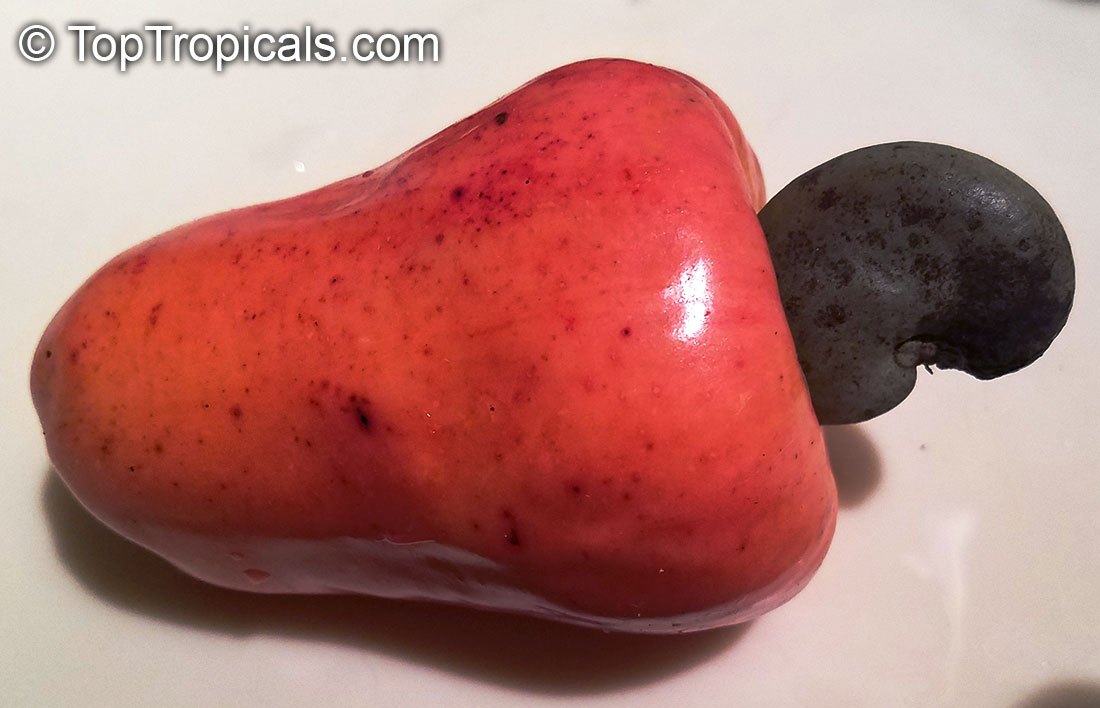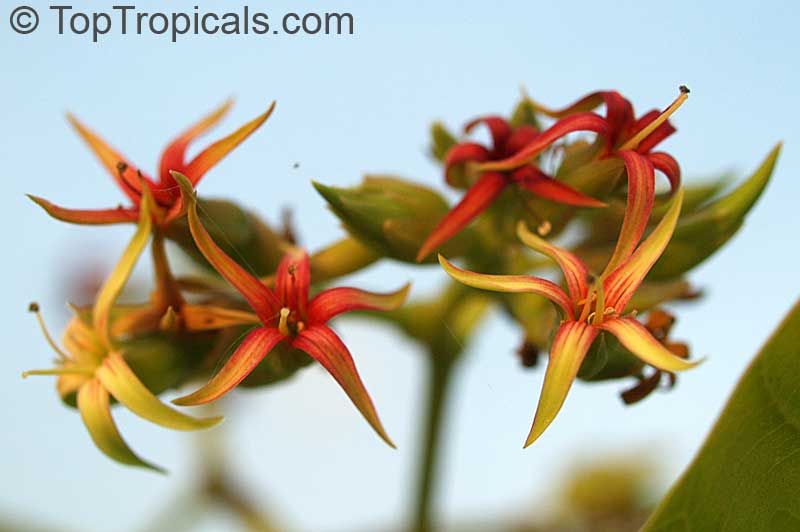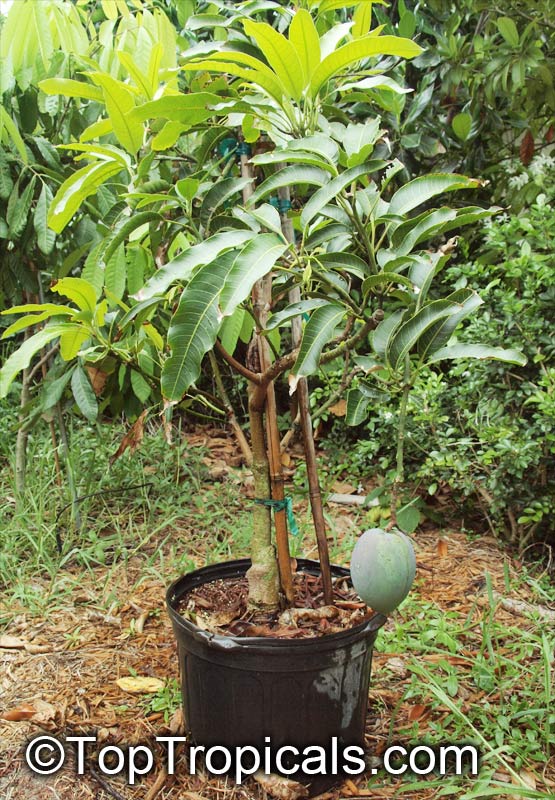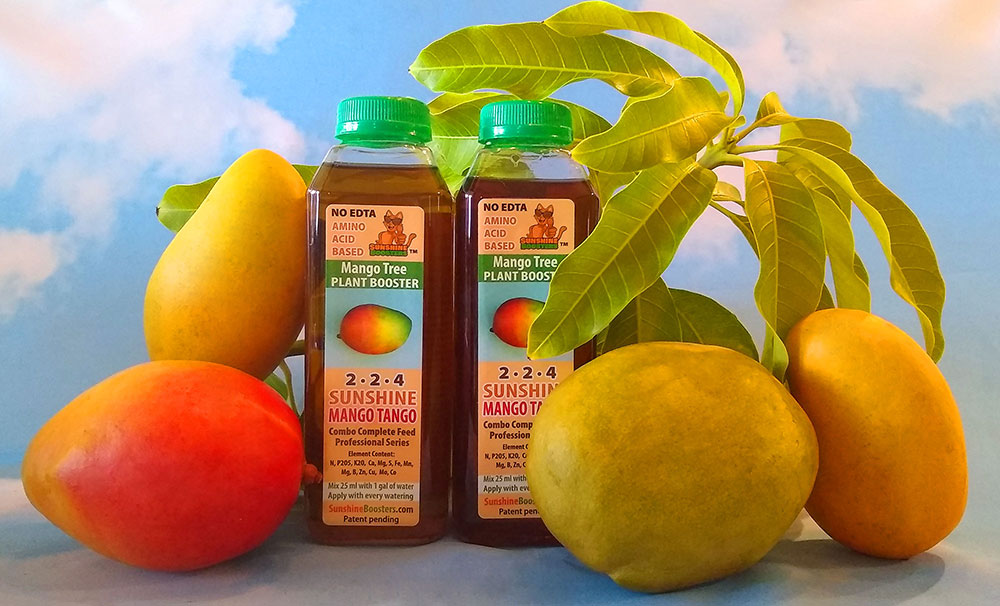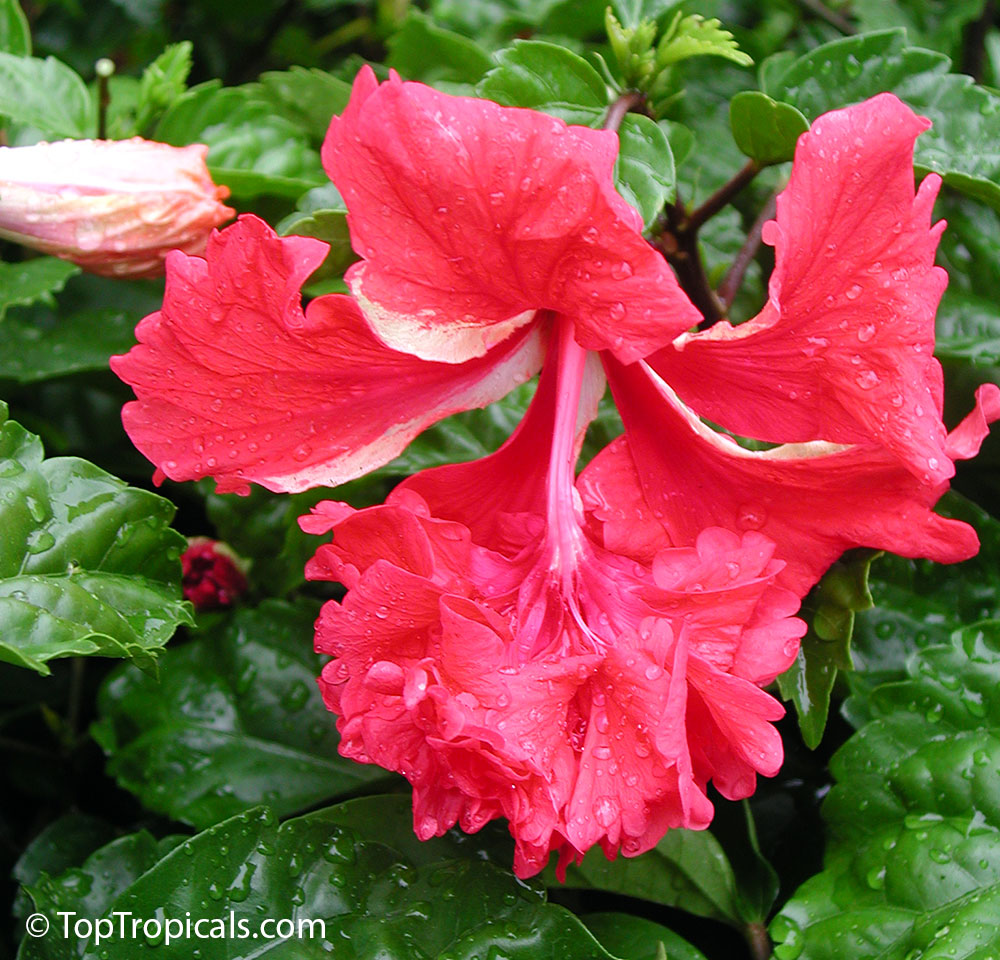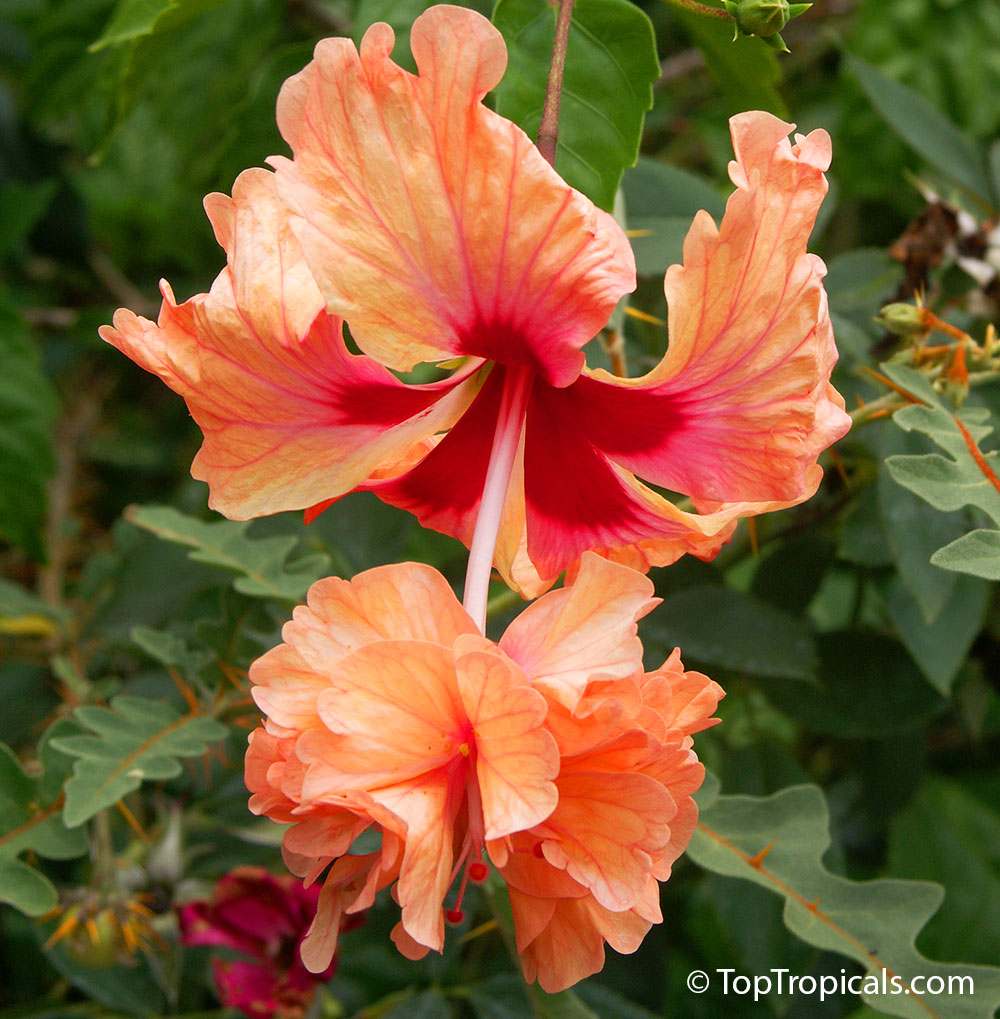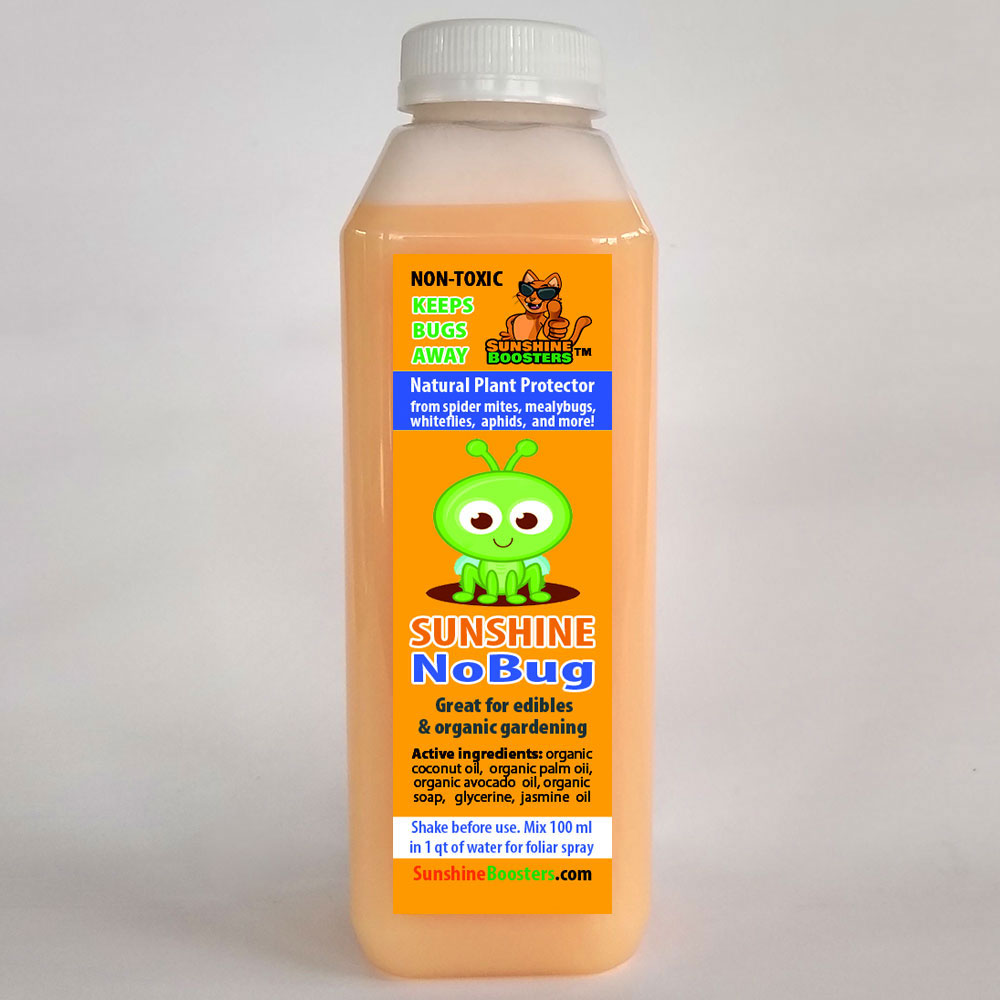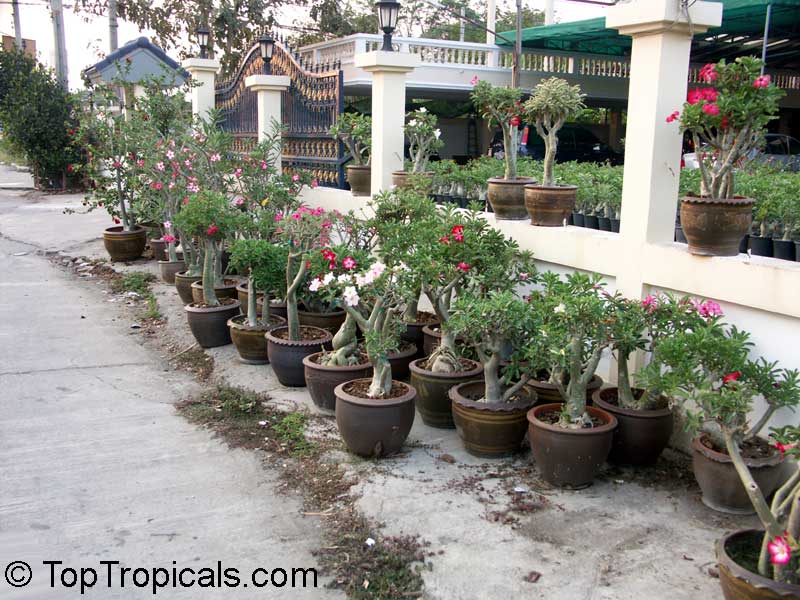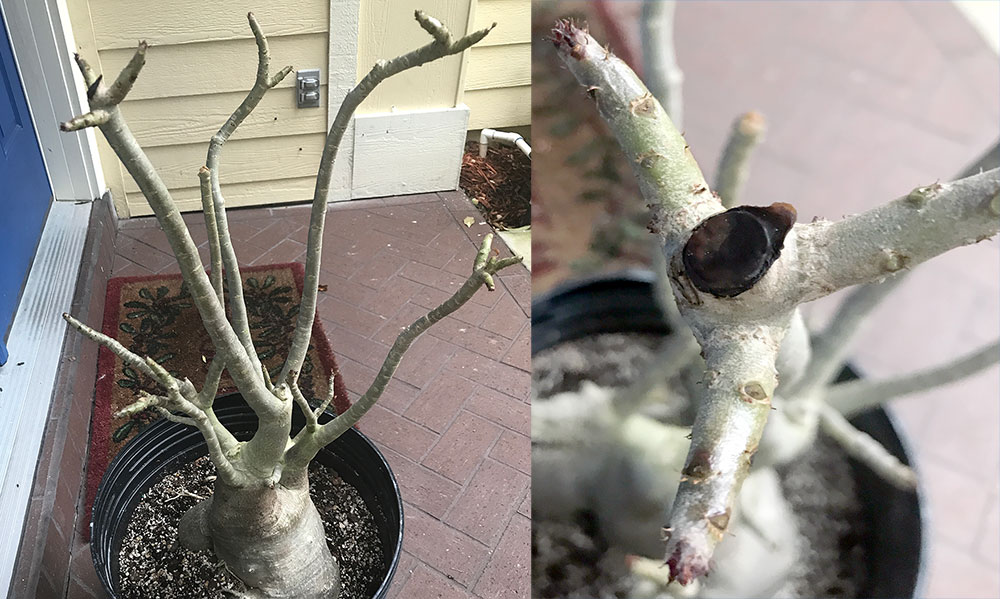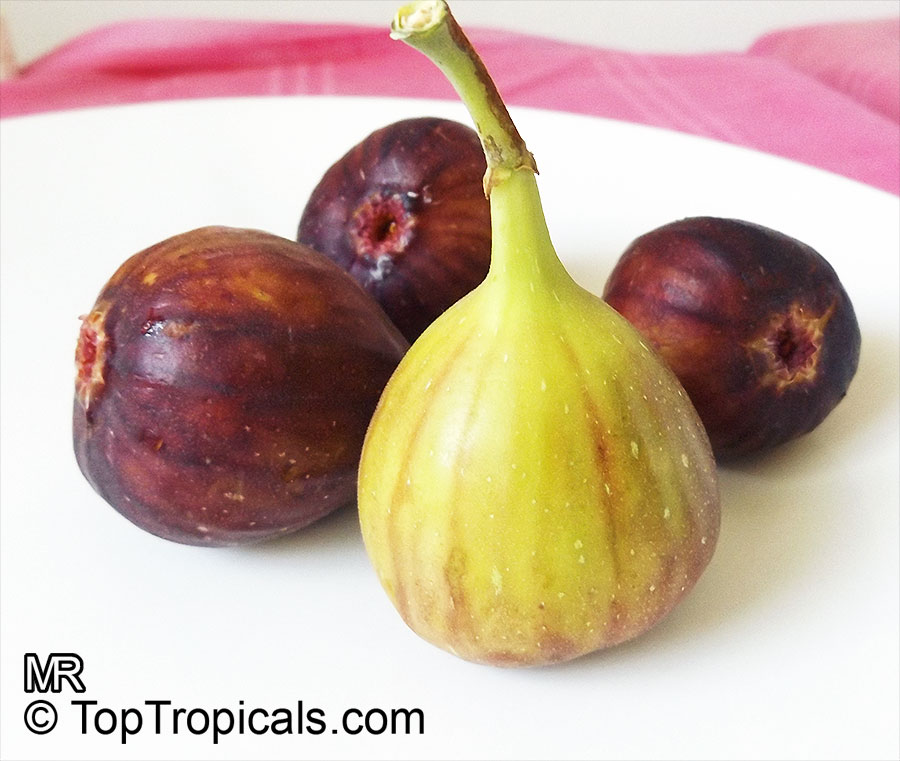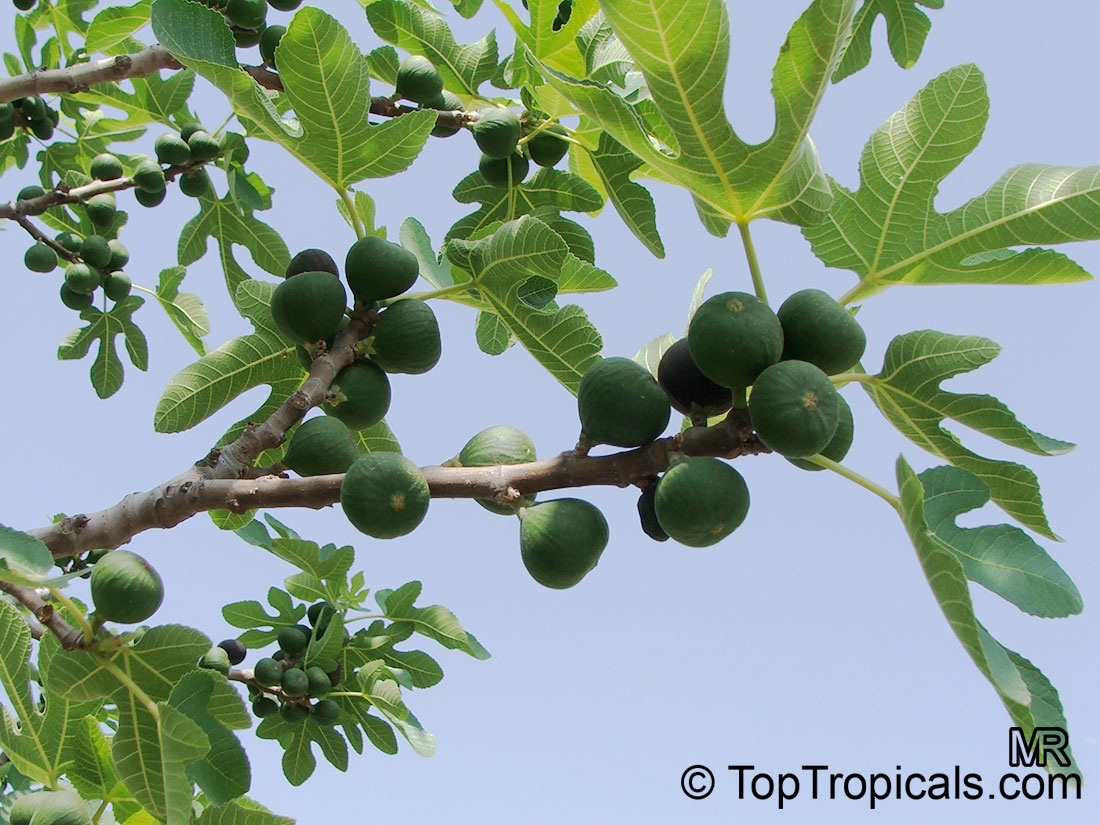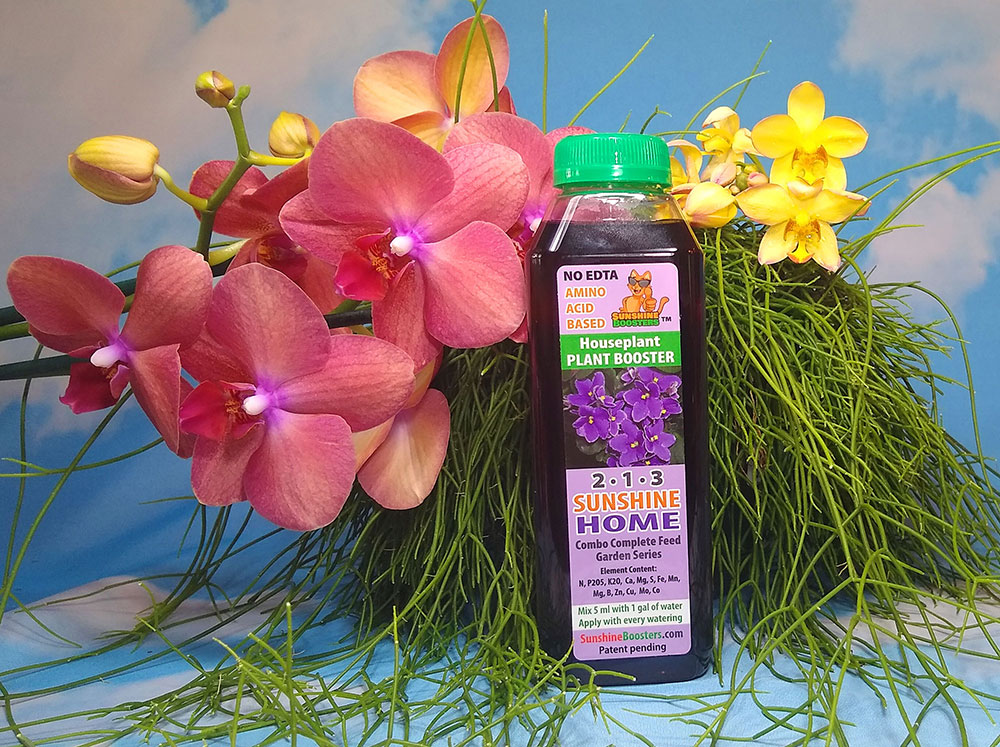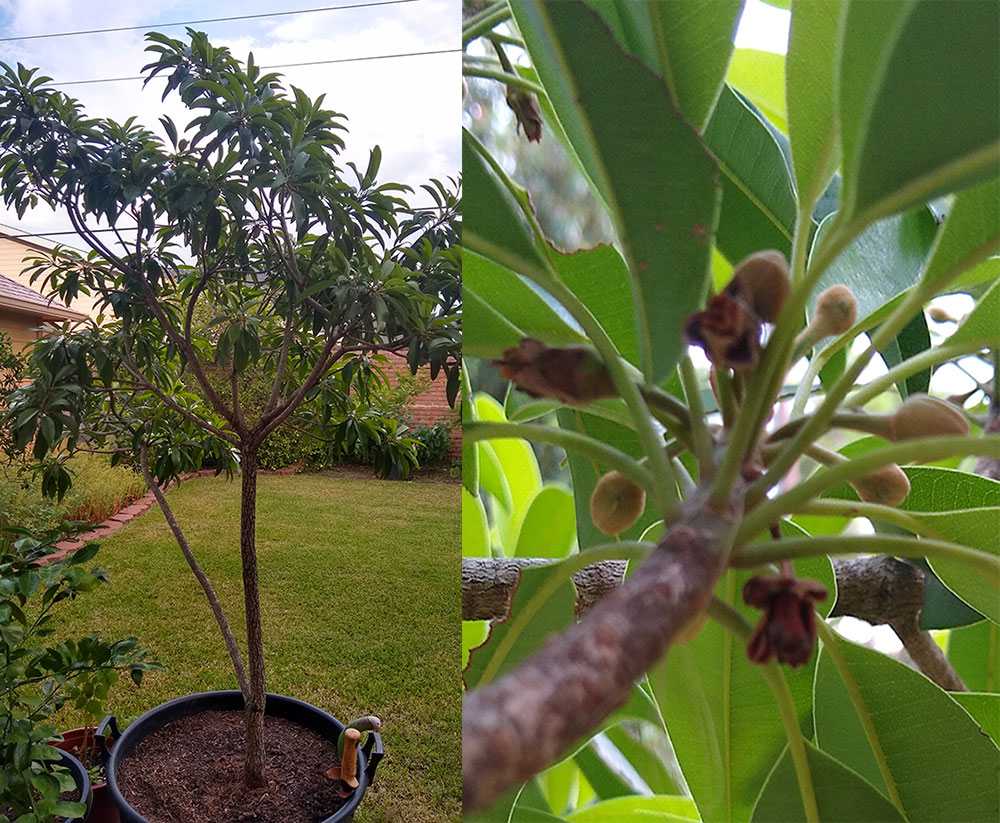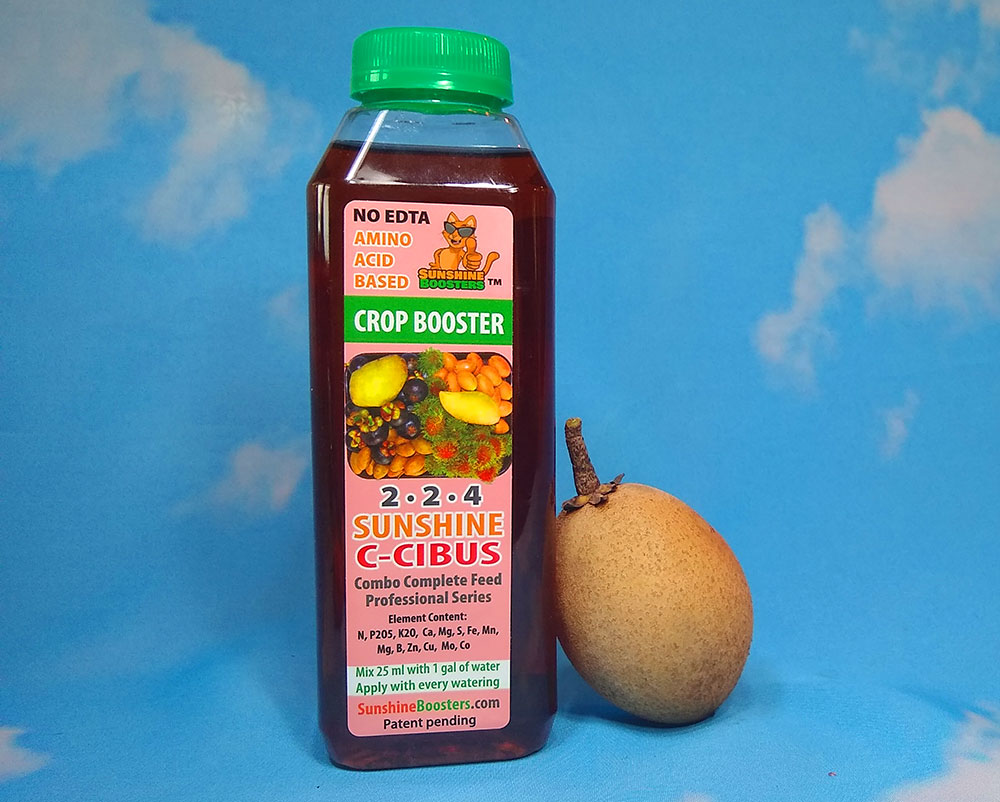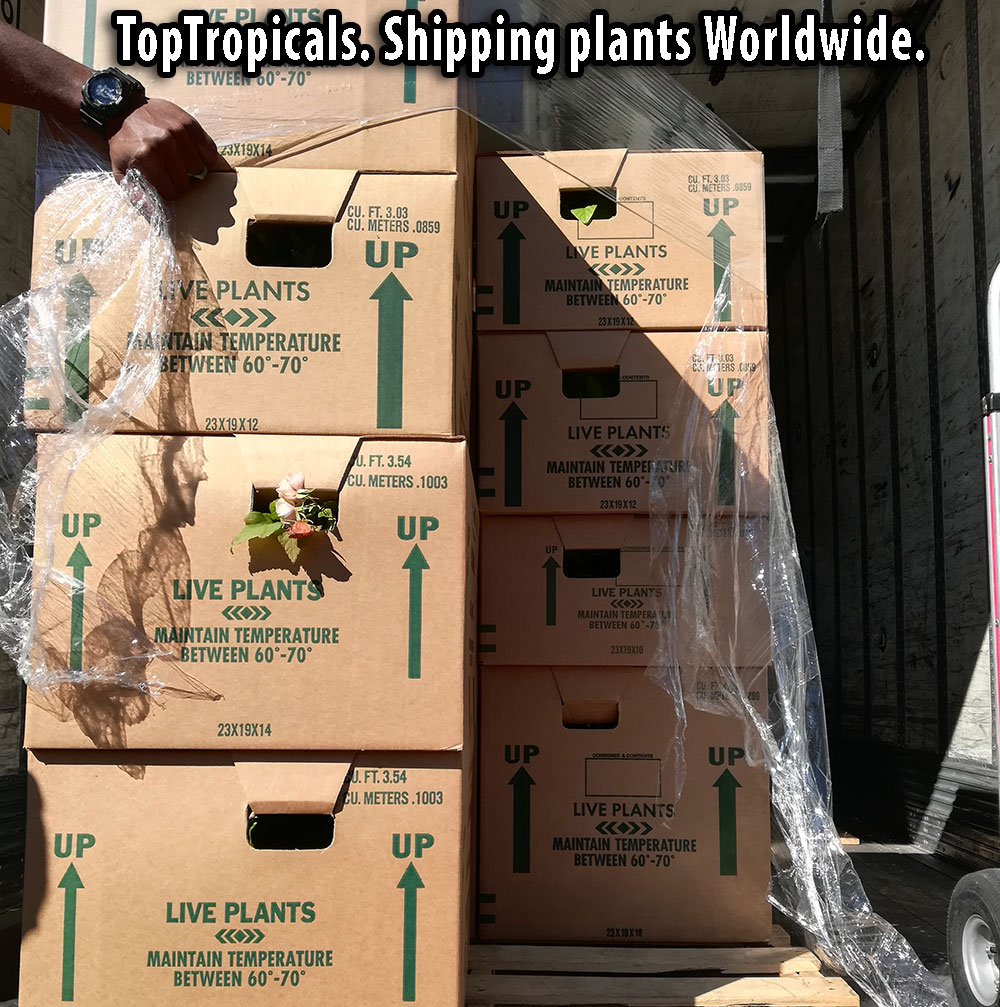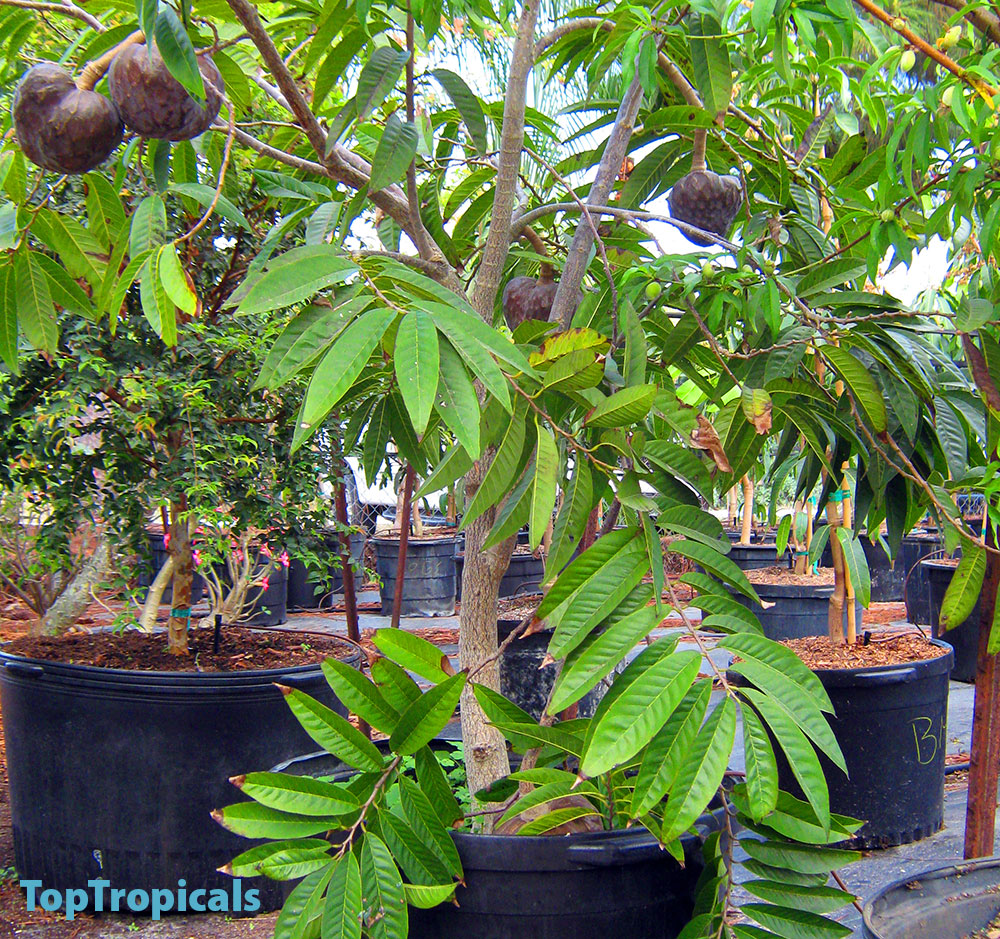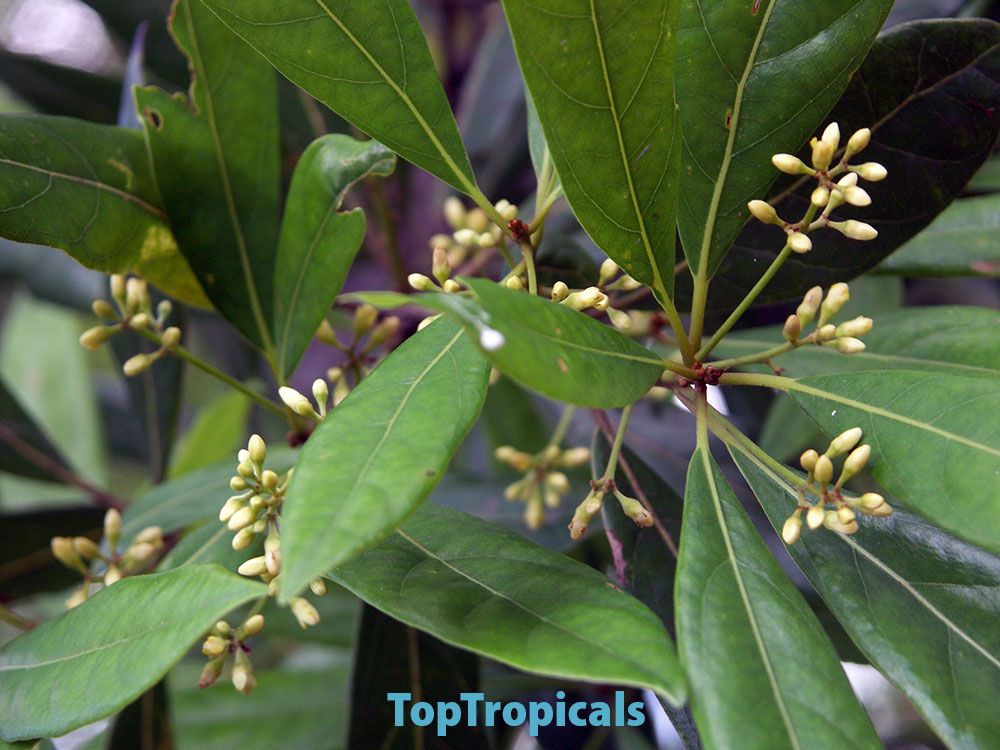Garden Blog - Top Tropicals
Date:
Cashew Nut tricks and challenges
Q: I bought a cashew plant in May of this year it has been slow-growing well then all of a sudden it started dying. I have cut it back halfway down. So a plant that was close to 3 ft tall is now 1 1/2 feet. I see new leaves trying to spring closer to the root. Help! It's in a huge 18" wide pot, I have not put it in the ground yet. I am in the Orlando area.
A: Generally speaking, Cashew is not the easiest plant to grow. Cutting it down added more stress to the plant. A few thoughts:
1) Chances are, the tree was over-watered (possibly summer rains, we had pretty wet summer this year in FL). Cashew trees are very sensitive to over-watering while young. Considering it sits in pretty large pot, this may have created soggy conditions. Don't bother repotting the plant now, just try to reduce watering. We have less rains now. If you have automatic sprinklers, move it away from sprinkler so you can control moisture manually. Even better - move it under roof (lanai, etc) where it still can get lots of bright light, but you can control water.
2) In Orlando, winters are too cold for this tree. Make sure to protect it from cold - bring inside when temperature drops below 65F, especially considering that the plant is still struggling.
3) Keep in mind that Cashew is semi-deciduous tree, meaning it looses leaves during cooler period. If all leaves are gone but the stem still green (after nail scratch) - just give it time, it may start growing vigorously in Spring.
4) You may apply Sunshine Boosters with every watering (which should be once a week, or even less frequent if the soil is still moist) - SUNSHINE C-Cibus - Crop Nutrition Booster
Keep the plant in full sun or at least very bright filtered light. It must be always warm. Bring inside if below 65F.
Photo above: Cashew Tree flowers are so amusing!
Date:
Healthy Plants. Q&A from Mr Booster: Fertilizing Mango trees in Winter
Q: I'm living in Maryland growing zone 7A and would like some info on when to fertilize my potted mango trees. I ordered your Sunshine Mango Tango 2-2-4. All your mango trees are in pots.
A: You can start using this fertilizer right away, any time of
the year, and every time you water your plants.
Sunshine Mango Tango, as well as other Sunshine boosters, is an amino-acid
based liquid fertilizer that is scientifically developed for daily plant
needs in all necessary nutrients. This means, you may use this fertilizer with
every watering, including winter period.
Traditional fertilizers (both granulated and soluble, EDTA-chelated) can
only be used during hot months while plants grow actively, and must be limited
or not used at all during cooler months, to avoid nutrient lock up in soil
(which basically means "building up unused elements"). With Liquid Sunshine Boosters, it is safe to add them every time you water
your tree.
During cooler weather and when plant metabolism slows down, a tree will
consume less water (as well as food), and you will automatically reduce
watering, to keep over-wintering plants on a dry side. This means, less fertilizer
too. This allows you to control elements intake naturally, like you control
water amount just as much as the plant needs.
Date:
Plant of the Month: Hibiscus El Capitolio
Stevie's Pick: what's in bloom?
Our exotic plant grower Steven Gowdy will spotlight the most interesting plants he discovers and recommends today while working in TopTropicals greenhouses.
OMG! These plants are awesome. The flowers are stunning, ruffled,
brightly colored. These are very unique double flowers about 5" long, with ruffled
petals, followed by a sort of a stamen, than more ruffled petals... Wow.
These are the perfect plants - they can be grown in a container or in-ground, in
full sun. They are drought and disease resistant, ever-blooming, can be
pruned into a standard weeping tree, or pruned into a bush... It's a convenient,
dream plant! Prune frequently, because it blooms on new wood.
Hibiscus El Capitolio grows best in zones 9 through 11. In colder
climates leave it in a container outside in the summer months, but bring inside in
the winter months.
Remember - ever-blooming! You prune and they will flower all year long.
These are fabulous plants that will satisfy any first-time or experienced
gardener: you just can't go wrong El Capitolio! They will have you growing
happiness... That's true.
Stevie with Kristi and Jamie celebrating his Happy Birthday. Check out Stevie's painting "TopTropicals Theme" at the beginning of this newsletter!
Date:
Healthy Plants: Q&A from Mr Booster
How to keep bugs away naturally?
Q: I started moving my tropical plant collection indoors as it's getting colder... And all of a sudden, I noticed bugs on leaves! I know for sure all my plants were bug-free when I kept the pots outside in my lanai. What happened? And how can I keep them clean and healthy without using any harsh chemicals? I have many edibles and herbs that I use in my cooking and prefer to stay away from insecticides. Any suggestions?
A: It is very common when healthy looking plants, once moved
indoors for the winter, get insect infestations. The main reason is change of
environment that puts a plant into stress and makes it susceptible to parasites
and diseases. Just think about what a plant is missing, a whole combination
of necessary conditions that provided a good life:
- Bring light -> light level reduced, so beneficial UV spectrum is gone
- Air circulation -> less wind = more bugs thriving
- Warm temperature -> from upper 80's in summer to 70's in your AC room
- Air humidity -> although humid air is believed to be causing some issues
(for example fungus), however, reducing humidity overall puts a plant into
stress and makes it more vulnerable.
Many gardener prefer to avoid chemicals, especially when it comes to treating edible plants and indoor collections. The solution to your problems is - Organic Solution!
SUNSHINE NoBug - Natural Plant Protector.
Shampoo for Plants - for both indoors and garden
SUNSHINE NoBug - is a natural solution to keep your plants healthy and
bug-free without harsh chemicals. It is great for organic gardening and
edibles, eco-safe and non-toxic for humans and pets.
It kills, repels and prevents: spider-mites, mealybugs, whiteflies, aphids
and many more. No wait time required - spray and play! And it smells like
jasmine, forget stinky insecticides!
How does it work? Just look at these ingredients: Kosher Glycerine, Organic
Coconut Oil, Organic Palm Oil, Oat Protein, Organic Soap, Horticultural Oil,
Jasmine Oil, Water. Yum! But bugs hate it - they suffocate in it! This is
why your plants will have NO BUGS with NoBug, that's it!
Directions are simple:
- Mix 100 ml (3-4 oz) with 1 qt (32 oz) of water, or 500 ml (16 oz) in 1
gal of water - for larger applications
- Spray foliage to drip point, including underneath leaves.
- Repeat the treatment in 7 days.
- As a preventive care, spray leaves once a month to keep insects away.
- You may use a paper towel saturated with this solution to wipe the leaves
and remove residue from insects.
- Store at room temperature.
This poor Pepper plant was tossed into garbage can by a neighbor... it looked hopeless, infested with mealybugs. We saved it with NoBug ! In 2 days it perked up, and after 4 weeks its healthy and fruiting!
Date:
Trimming and treating Adeniums in winter
Q: My desert rose below dropped leaves after I replanted it in a bigger pot. I noticed that one of the branches that had been pruned is black at the tip. Please let me know if the section of the branch that turned black needs to be cut. I also wasn't sure how often to water it since the leaves have all dropped. None of the other dessert roses have dropped their leaves but they are all younger plants. Any advice would be much appreciated.
A: Your plant looks healthy and vigorous overall. Dropping leaves
after repotting, or shipping, especially at this time of the year, is normal
in Adeniums. They are deciduous and stay leafless from Fall to Spring.
Some individual specimens can go into dormancy sooner than others - all depends
on conditions: temperature, light, exposure, etc. and individual plant's
"clock".
The black spot on the cut branch may be a sign of a fungus as a result of
excess water.
You may carefully clean/rub it with a paper tower dipped in Hydrogen
Peroxide (pharmacy grade). Then rinse with fresh water.
Keep the plant warm and in a dry spot. Once leaves are dropped, it doesn't
need much water. Once a week watering is enough.
Date:
What fig trees are good for Florida?
Q: My baby fig tree was sprayed by the lawn people with weed killer :( Any ideas? Also what figs do you have available to grow here in Florida?
A: Unfortunately once a plant is affected by a herbicide, there
is not much you can do about it.
If you don't rinse the chemical within a few seconds, it gets into the
plant internal system and nothing can be done to save the plant. The tree may
remain green for a few days up to a week, but then gradually dies back. If your
fig tree wasn't rinsed immediately after herbicide spray, it is probably too
late.
If you want to replace it with a new one, here is a few suggestions of our
favorite fig varieties which are great producers and grow well in Florida
heat:
Brown Turkey Fig - our favorite!
Black Mission Fig
Beers Black Fig
Texas Everbearing Fig
Magnolia Fig
LSU Purple Fig
Olympian Fig
Texas Blue Giant Fig
See full list of Fig Trees.
Make sure to get appropriate plant food for your fig tree so it develops faster for you and gets well-established before winter: SUNSHINE C-Cibus - Crop Nutrition Booster from Garden Series, or Combo Total Feed Collection - all nutrients in just one bottle, for fruit trees and edibles.
Date:
New video: Ground orchids.
All-summer colors for shady gardens
Did you know orchids can be grown in the ground?
Orchids have a mystique that seems to set them apart from most other
flowers... they are elegant and almost unreal in their perfection... The symmetry
of the flowers has led to the orchid being a symbol of a perfect beauty.
But not every gardener has luck growing traditional orchids. Some complain
about their special maintenance:
"Mount them on a tree, do not overwater... and all that hassle just for
once-a-year flower?" Sounds familiar?
Terrestrial orchids (a.k.a. ground orchids) grow in regular garden soil
instead of in the air on tree branches. And they bloom almost year round!...
Ground orchids are available from our store.
Stay updated with TopTropicals Videos by subscribing to our channel at YouTube.com/TopTropicals and get our latest video news of what is fruiting and blooming!
Remember to get plant food for your orchids and Ground
orchids!
In the photo: Sunshine-Home, plant booster for tender house plants and orchids.
Date:
Healthy Plant Food: Q&A from Mr Booster
Why my Sapodilla is not fruiting?
Q: I bought a Sapodilla tree from you several years ago, Silas Woods. I live in Houston area. The tree grows and produces blossoms for fruits, but then they just dry up and fall off. To-date, I have not gotten any fruits off the tree. Is there a reason for this? I really want a fruiting tree because Sapodilla is one of my favorite fruits. I have attached pictures of the tree. Please help.
A: Silas Woods is a free-flowering variety and in favorable conditions it should produce fruit almost year round, considering warm temperatures. The fact that the tree is producing flowers indicates that it is strong, overall healthy and ready for production, but for some reason these flowers don't set fruit. There may be several reasons for such behavior.
1) Too high temperature and too low humidity
In Houston area, humidity should be good in summer. However, if
temperatures stay above 90F for a long time, this may cause flower dry-n-drop.
Solution: try to move the potted tree into filtered light, or in a
spot where it does not get direct burning sun during the hottest hours of the
day (morning sun is the best)
2) Root bound.
Solution: check if the tree needs stepping up into a larger
container.
3) Lack of certain nutrients that are responsible for proper fruit
formation.
In particular, elements B (Boron), Mo (Molybdenum), and a few other
micro-elements (Fe - iron, Cu - Copper, etc.). This is most likely the cause of a
flower drop. This is very common reason for undeveloped fruit or lack of fruit
in container-grown fruit trees. When grown in the ground, plants can reach
out to all necessary elements in surrounding soil (considering soils are not
too poor on necessary elements). In a pot, a supply of nutrients can be
exhausted very quickly, so a quality fertilizer program is very important.
Fertilizer must include all necessary nutrients in easy accessible form, and a plant
must have their constant supply for proper development.
Solution: prescribe to your Sapodilla tree the following combination
of plant food:
- SUNSHINE C-Cibus - Crop Nutrition Booster. It will provide
well-balanced amounts of high absorption Nitrogen, as well as other macro-elements - to
provide enough energy to the tree, plus a combination of all necessary
micro-elements. It is safe to apply this fertilizer as frequent as with every
watering, including winter time.
- SUNSHINE-Honey - sugar booster. This supplement has a high content of
elements Mo and B - once the tree starts getting them on regular basis (a few
times a year, according to the label), it will change its habit dropping
flowers and/or premature fruit drop. As extra bonus, Sunshine Honey makes fruit
sweeter by bringing sugars from all over the plant and concentrating them into
fruit.
4) Lack of pollinating insects.
Solution: For most effective pollination, we always recommend to put
some pieces of fruit under the tree, apple peels, or even banana peel. Those
attract tiny beetles that are responsible for small flower pollination.
With winter time approaching, fruiting season is about to end, however, do not get discouraged and start the fertilizing program right away: this will bring up the plant into a healthy stage within a few months, and by next season it should be covered with fruit you like so much! Remember, Sunshine liquid fertilizers can be used year round, including winter, without a risk to burn roots or overdose, as long as you follow label instructions.
SUNSHINE C-Cibus - Crop Nutrition Booster from Garden Series, or Combo Total Feed Collection - all nutrients in just one bottle, for fruit trees and edibles.
Date:
Shipping Tropical Plants Worldwide
Q: We are very interested in introducing frost-hardy avocado varieties into Switzerland. We would really, really like to have our own avocados in our garden. And we believe that the plants have a large sales market here. Do you see a way to send some plants to Switzerland? Which varieties would you recommend, which are the cold-hardiest?
A: Yes, we do ship plants all over the world, including Europe. For basic information on international shipping, please refer to these guidelines. Shipping plants internationally is a bit complex procedure, however we have over 17 years experience with that and you came to the right place. For a quote on shipping cost and to make sure you get all the necessary paperwork, contact our international department direct number 239-771-8082 or email us .
Regarding your questions about Avocado varieties:
First, please take a look at Cold hardy Avocado varieties guide pdf file. The most cold hardy
varieties like Brazos Belle, Fantastic, Joey, Lila, Poncho, Winter Mexican - can
take short period of light freeze as long as they well established. This means,
for the first year or two you need to protect them from freeze. Keep in mind
that if you have hard freeze every night for several weeks, then even
cold-hardy Avocados must be grown with cold protection. It is possible to do by
creating a greenhouse/conservatory around plants in the ground, see example from one of our customers in Virginia. Even better - grow them
in large pots. This way plants will be easier to handle and move around as
needed. See the photo above of avocado production in pots.
Date:
Fast-fruiting trees?
Photo above: Annona reticulata - Red Custard Apple
Q: More of a question than a review, but a review regarding your catalog, it would be easier for us buyers, if we could search for plants that produce fruit in 2 years or less, I don't have the patience to wait longer than that for fruit. I'm trying to buy for a fairly good sized garden but want some fast growers and fruit produced in 2 yrs. Can you help me out?
A: Fruiting time depends on many factors (established size,
growing conditions, fertilizing, and even specific variety), this is why we can
not just put a simple icon "will fruit within 2 years".
However, most grafted and air-layered fruit trees, including all Mango, Avocado, Loquat, Sapote, Sapodilla, Lychee/Longan, Peaches and Nectarines - will fruit right away. If you see in our store
"grafted" or "air-layered" in plant description - these trees will fruit
soon. Some of them already flowering and fruiting.
Some non-grafted trees or seedlings like Annona, Artocarpus (Jackfruit), Eugenia, Guava, Banana, Dragon fruit, Mulberry, Blackberry/Raspberry - will fruit within 3-4 years from seed or even
sooner (Banana, Mulberry, Dragon fruit, Blackberry-Raspberry - within a year).
Usually it says in description that this plant can produce fruit soon.
Bigger size plants are more established and have more energy to produce, so
try to get larger size plants if your budget permits, and especially if you can
pick up bigger plants rather than shipping them - obviously, shipping has size
limitations.
In addition, all spice trees like Bay Leaf, Bay Rum, Allspice and many more - they will
produce spice for you right away, so you don't need to wait at all!
If you have questions about fruiting time on any specific plant you put
your eye on, don't hesitate to ask!
Photo above: Pimenta dioica - Allspice
